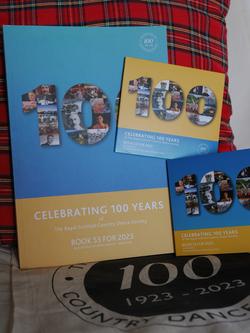28 August 2023: Sneak Preview: Book 53
It must have made the rounds by now: The Royal Scottish Country Dance Society, or RSCDS – affectionately called “the Society” by Scottish country dancers – is turning 100 this year! And even if it has seen better times, for example as far as membership numbers are concerned, it is still spry with considerable potential for the future. Celebrations last throughout the year, and one component of the festivities is the anniversary book of dances which appeared in July and at which we want to take a somewhat closer look today – also as a “teaser” for dancing from September, as we’ll be sure to try some of the dances from Book 53.
“Publication of dance descriptions in simple form and at moderate price” is one of the RSCDS’s declared goals, and starting with Book 1 in 1924 it has amassed a considerable repertoire of dance books already – apart from the “numbered series”, where a new book appears yearly or every few years, there are various works for certain audiences (such as the Books of Graded Dances for teaching beginners, or Jigs and Reels for schools) and exotic stuff (e.g., the famous/notorious MacNab Dances). In former times members were sent a “numbered” book every year – either the newly-published one, or, in so-called “fallow years” without a new publication, another one of their choice; today this is no longer the case because the semiannual members’ magazine is considered more worthwhile. Even so, “numbered” books keep appearing – which one must now order specially –, and by now we’re up to Book 53. After a creative pause of some years it is the first book in the series to appear in the 2020s, and on the occasion of the anniversary, the community naturally expects something appropriately special. Let’s look at how this turned out.

The selection of dances is based on suggestions by RSCDS branches world-wide and represents a mixture of new and not globally well-known dances and “golden oldies” which have in some cases been part of the popular repertoire for a very long time but not been officially “taken on board” by the Society – including, for example, Jennifer's Jig, Schiehallion and Nottingham Lace, the Pinewoods Reel and Seton's Ceilidh Band. As original descriptions of these dances are sometimes difficult to come by it is nice that the Society is taking care of them, even though these can of course only represent the very tip of the iceberg. Having said that, there is enough new(ish) material in the book to make it interesting even to those with a well-stocked library of dance descriptions, and the lesser-known dances will, through their inclusion in this book, hopefully become much more popular.
At any rate, one dance from Germany has made the book – Carola Fischer’s relatively early composition, The Willbergs of Rechberg, dedicated to the couple who founded the SCD group in Schwäbisch Gmünd (like the FSCDC e.V. one of the first in Germany) and established the widely-popular Rechberg dance weekend. (Carola told me once how as a fresh arrival in Germany in the 1970s she ended up in Hans Willberg’s German-for-foreigners language class at the Schwäbisch Gmünd adult education centre, and was immediately ordered to join his wife’s SCD class so she would meet people. In 1986, Karin Willberg was the first German to be presented with the Society’s Scroll of Honour for her efforts.)
During the upcoming weeks and months we at the FSCDC e.V. will surely take a closer look at the dances in the book. Of course the Society also provides music – distributed across two separate CDs, which were recorded by David Oswald and his Scottish dance band and Nicol McLaren and the Glencraig Scottish Dance Band, respectively. I haven’t yet had occasion to listen to all the tracks (which in each case include not just the dances but also some choices by the bands), but what I’ve heard so far sounds very good, and with these big names involved one expects nothing less. The CDs will surely come up again in this blog.
Overall, one thing is very clear: This time, the Society has spared no trouble or expense. The multitude of dances in the book, with a wholesome base of popular perennials and a spicy garnish of lesser-known material, together with the special anniversary character of the project, invites surely well-deserved interest. On the other hand, the Society has now demonstrated how high-quality dance books can also be presented, and thereby raised the bar considerably for future projects. We’re waiting with bated breath for Book 54.
(Many thanks to Susanne Staub and Matthias Lang for procuring the book and CDs on my behalf in St. Andrews.)
Text and photographs: Anselm Lingnau